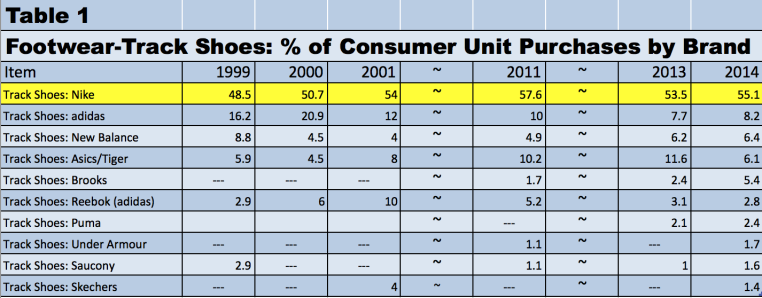Some History and an Inquiry
Nike, Greek for victory, is the company that has made tremendous strides in the sports business world. A key to success seems to be their long-lasting marketing campaign “Just Do It.” My question, however, is should someone go out there and “Just Do It”? OR should they learn the correct techniques, drills, styles, and form so that they do it correctly and thus are able to do it on a long-term basis with greater benefits?
Some Facts and Statistics
Founded in 1964 (Forbes, 2015) and kindled by the great Coach Bill Bowerman, Nike started out as a man creating shoes out of his basement using a waffle iron. The company has come leaps and bounds since those humble beginnings and now boasts a market capitalization of $86.2 billion (Forbes, 2015). Market trends, at least those relating to Track and Field shoes, show that Nike has the highest unit purchases over the past ten years compared to other well-known running brands, such as Adidas, Asics, and New Balance just to name a few (See Table 1).

The Campaign: Just Do It
As previously mentioned, a catchy and inspiring marketing strategy seems to be the key to Nike’s success. The company is famous for its well-known slogan “Just Do It.” These three words, adopted in 1988, jump-started Nike’s climb to becoming #18 on Forbes’ List of Most Valuable Brands (Forbes, 2015). Amazingly, the campaign allowed Nike to more than double its “share of the North American sports-shoe business from 18 to 43 per cent between 1988 and 1998” (Close-Up, 2015). That is, the “Just Do It” campaign increased Nike shares by 26% in just ten years. The campaign is still running to this day making it a 27-year marketing strategy that has helped Nike bring its sales up to $30.32 Billion (Forbes, 2015).
The slogan had a personal impact on consumers. It made them “believe they could be successful too just by wearing [Nike’s] products” (Close-Up, 2015). However, there was hesitancy towards the slogan. According to the Nike Close-Up article, “‘Just do it’ was imperative, impatient, presumptuous and a little rude” and it was not “the sort of thing consumers had heard before” (Close-Up, 2015). Nike took a risk when launching their “Just Do It” campaign. Their gamble, however, yielded rich rewards, as seen by their increasing revenues and profits (Table 2).

The Problem
Consumers took to the slogan as the “brand has now become instantly recognizable as one of the world's most popular sports companies” (Connect, 2015). Anytime someone hears the words “Just Do It,” Nike pops into their head. Anytime someone sees that iconic Swoosh, the word Nike flashes before their eyes.
The problem, however, comes from interpretation. According to the article Connect: Behaviour – Language: Barrier and A Gateway, language can be unclear and “words can be interpreted in many different ways.” Thus, many people go out and “Just Do It” on the track or in the gym with those three words in their heads to motivate them. There are two types of people: those who have had background experience or training and know how to do it versus those who just wing it without the necessary knowledge of how to do it. Although the slogan is meant to motivate consumers to get active, it can be detrimental if no previous training has equipped them to do certain activities correctly.
An Example
Often people are out on the trail with poor running form. All that they need is for someone to tell them to bring their shoulders back or lift up their knees or even relax their hands. This posture-change would improve their form and increase their efficiency so that, in the long run, they would receive a greater benefit out of the activity and decrease the risk of injury. In this instance, “Just Doing It” was not as beneficial as first receiving training or advice, taking time to learn what is necessary to do it, and then following up with someone who has experience with the activity. Therefore, should people “Just Do It”? Or should they first “Learn it”?
The Takeaway
The Nike campaign “Just Do It” has had obvious success. However, it can encourage people to perform an activity without the necessary knowledge required to obtain the maximum benefit that that activity has to offer. Therefore, one should not “Just Do It,” but “Learn It” as well.
This blog post was written by Samford University student Margaret A. Grogan.
References
Close-Up: The history of advertising in quite a few objects - No 118: Nike's 'Just do it' tagline. (2015, January 23). Campaign, 12.
Connect: Behaviour - Language: a barrier and a gateway. (2015, June 1). Marketing Event, 66.
Footwear-Track Shoes: % of Consumer Unit Purchases by Brand. (n.d.). Retrieved September 5, 2015
Forbes. The World's Most Valuable Brands: #18 Nike. (2015). Retrieved September 4, 2015
Just Do It! (n.d.). Retrieved September 4, 2015
Sporting Goods Footwear Company Revenues and Profits (in mil. of $). (n.d.). Retrieved September 5, 2015
